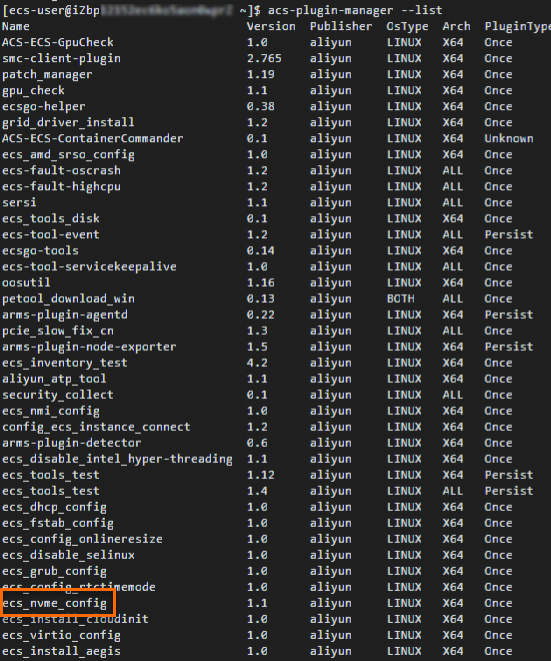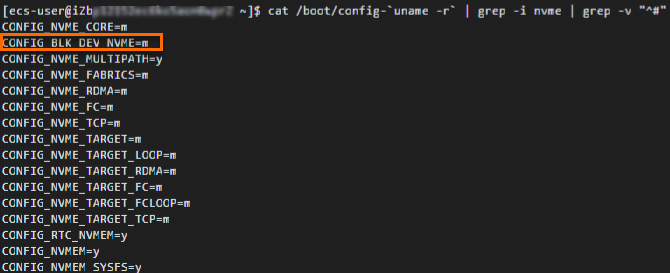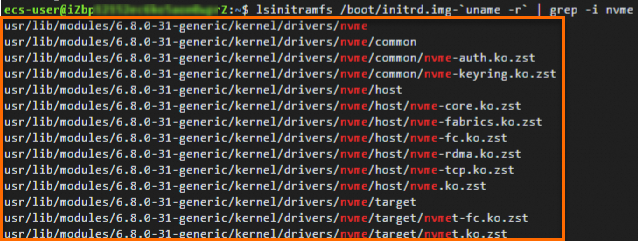If you want to use an existing custom image on which no Non-Volatile Memory Express (NVMe) driver is installed to create an Elastic Compute Service (ECS) instance and use NVMe to improve storage performance, you can follow the steps described in this topic to install the NVMe driver on the custom image. This helps you ensure that the ECS instance starts as expected and your business stably runs.
NVMe is a high-speed interface protocol for solid-state storage such as flash-based SSDs. NVMe delivers faster response and higher bandwidth than traditional driver protocols, such as Small Computer System Interface (SCSI) and virtio-blk. For more information about NVMe, see NVMe protocol.
Problem description
If the NVMe driver is not installed on a custom image, you can perform the operations described in this topic in the following scenarios:
When you import a custom image to Alibaba Cloud, the Image Check feature detects that the NVMe driver is not installed on the image.
When you purchase an ECS instance that supports NVMe, you cannot select a custom image. This issue may occur when the custom image does not match the NVMe attributes of the instance type.
NoteFor information about instance families that allow NVMe disks to be attached, see Overview of instance families. You can configure the
NvmeSupportparameter when you call the DescribeInstanceTypes operation to check whether the instance family supports NVMe.You can check whether a custom image supports NVMe by configuring the
NvmeSupportparameter when you call the DescribeImages operation.For more information, see Why am I unable to find specific images when I create ECS instances?
Procedure
Create an ECS instance from an existing custom image to transfer data of the custom image to the instance.
For more information, see Create an instance by using a custom image.
ImportantYou are charged for the intermediate ECS instance that you create. After you create a custom image from the intermediate ECS instance, we recommend that you release the intermediate ECS instance at the earliest opportunity. For more information, see Release an instance.
Connect to the new ECS instance.
For more information, see Connection method overview.
Check whether the NVMe driver is installed on the ECS instance. If the NVMe driver is not installed, install the driver.
Automatic configuration by using Cloud Assistant
Cloud Assistant provides the
ecs_nvme_configplug-in to help you quickly complete the NVMe driver configuration based on the operating system.Run the following command to check whether Cloud Assistant Agent is installed on the instance, and if Cloud Assistant Agent is installed, check whether Cloud Assistant Agent provides the
ecs_nvme_configplug-in:acs-plugin-manager --list
If no Cloud Assistant Agent information is returned, you must install Cloud Assistant Agent on the instance. For information about how to install Cloud Assistant Agent, see Install Cloud Assistant Agent.
If a list of Cloud Assistant plug-ins is returned and the
ecs_nvme_configplug-in appears, proceed to the next step.
Use the
ecs_nvme_configplug-in to configure NVMe-related settings.Run the following command to use the
ecs_nvme_configplug-in to check whether the instance has the NVMe module and whether the instance supports the NVMe module:sudo acs-plugin-manager --exec --plugin ecs_nvme_config --params --checkIf the following message is returned, the NVMe driver is installed on the instance. You can create a custom image without the need to configure the NVMe driver.
[SUCCESS] Summary: Your image can Runnig on nvme instanceIf a message similar to the following
errormessage is returned, proceed to the next step.[ERROR] 1.initrd/initramfs not has nvme module, Please run acs-plugin-manager --exec --plugin ecs_nvme_config --params -f/--fix to enable nvme;
Configure the NVMe driver and relevant parameters based on the error message in the command output.
sudo acs-plugin-manager --exec --plugin ecs_nvme_config --params --fixAfter you configure the NVMe-related settings, run the following command to restart your instance:
sudo rebootAfter you restart the instance, run the following command to check whether the NVMe module is configured:
sudo acs-plugin-manager --exec --plugin ecs_nvme_config --params --checkSample success output:
[OK] 1.initrd/initramfs already contain nvme module; [OK] 2.fstab file looks fine and does not contain any device names; [OK] 3.The nvme parameters already included. [SUCCESS] Summary: Your image can Runnig on nvme instance
Manual configuration in CentOS or Alibaba Cloud Linux
Run the following command to check whether the kernel loaded the NVMe driver:
cat /boot/config-`uname -r` | grep -i nvme | grep -v "^#"
If the
CONFIG_BLK_DEV_NVME=ymessage is returned, the operating system can start on an instance of an instance family that supports NVMe. In this case, proceed to Step 3.d.If the
CONFIG_BLK_DEV_NVME=mmessage is returned, perform the following steps in sequence.
Run the following command to check whether the initial Resource Access Management (RAM) file system (initramfs) contains the NVMe driver:
sudo lsinitrd /boot/initramfs-`uname -r`.img | grep -i nvme | awk '{print $NF}'
If the command output shown in the preceding figure is returned, the operating system can start on an instance of an instance family that supports NVMe. In this case, proceed to Step 3.d.
If the command output shown in the preceding figure is not returned, perform the following steps in sequence.
Run the following commands in sequence to configure the initramfs to support the NVMe driver:
mkdir -p /etc/dracut.conf.d echo 'add_drivers+=" nvme nvme-core "' | sudo tee /etc/dracut.conf.d/nvme.conf > /dev/null sudo dracut -v -fNoteIf the dracut tool is not installed in your operating system, run the sudo yum -y install dracut command to install the dracut tool first.
Add the NVMe-related
io_timeoutparameter to the GRand Unified Bootloader (GRUB) file.NoteThe
io_timeoutparameter is added to the GRUB file to fix timeout errors related to the NVMe devices in the Linux operating system. If you set the io_timeout parameter to the maximum value, the operating system can continue to process I/O requests from NVMe devices, regardless whether a timeout occurs.In most Linux distributions, the
io_timeoutparameter defaults to 30. Unit: seconds. In a new version of the kernel, set theio_timeoutparameter to the maximum value of 4,294,967,295 seconds. In an earlier version of the kernel, set the parameter to 255 seconds.
Run the following command to open the GRUB file:
sudo vi /etc/default/grubPress the I key to enter Insert mode. At the end of the
GRUB_CMDLINE_LINUX=line, add thenvme_core.io_timeoutand nvme_core.admin_timeout parameters and set them both to 4294967295.The following figure shows an example on how to add the parameters.
 Note
NoteIf the GRUB file already contains the preceding parameter settings, you do not need to add the parameters again.
Press the Esc key to exit Insert mode. Then, enter
:wqand press the Enter key to save and close the file.
Apply the GRUB configurations.
Run one of the following commands based on the boot mode of the ECS instance:
Legacy BIOS boot mode
sudo grub2-mkconfig -o /boot/grub2/grub.cfgUnified Extensible Firmware Interface (UEFI) boot mode
sudo grub2-mkconfig -o /boot/efi/EFI/centos/grub.cfgNoteFor information about the boot modes of ECS instances, see Best practices for ECS instance boot modes.
Run the following command again to check NVMe-related information:
sudo lsinitrd /boot/initramfs-`uname -r`.img | grep -i nvme | awk '{print $NF}'If the following command output is returned, the configuration is complete and the operating system can start on an instance of an instance family that supports NVMe.

Manual configuration in Ubuntu or Debian
(Optional) Run the following command to view the NVMe drivers included in the initrd:
lsinitramfs /boot/initrd.img-`uname -r` | grep -i nvmeThe following command output indicates that the NVMe driver is loaded in the initrd of the Ubuntu operating system.

Add NVMe-related
io_timeoutparameters to the GRUB file.NoteThe
io_timeoutparameter is added to the GRUB file to fix timeout errors related to the NVMe devices in the Linux operating system. If you set the io_timeout parameter to the maximum value, the operating system can continue to process I/O requests from NVMe devices, regardless whether a timeout occurs.In most Linux distributions, the
io_timeoutparameter defaults to 30. Unit: seconds. In a new version of the kernel, set theio_timeoutparameter to the maximum value of 4,294,967,295 seconds. In an earlier version of the kernel, set the parameter to 255 seconds.
Run the following command to open the /etc/default/grub file:
sudo vi /etc/default/grubPress the I key to enter Insert mode. On the
GRUB_CMDLINE_LINUX=line, add thenvme_core.multipath, nvme_core.io_timeout, and nvme_core.admin_timeout parameters. Then, set nvme_core.multipath to n and nvme_core.io_timeout and nvme_core.admin_timeout both to 4294967295.The following figure shows the parameters.
 Note
NoteIf the GRUB file already contains the preceding parameter settings, you do not need to add the parameters again.
Press the Esc key to exit Insert mode. Then, enter
:wqand press the Enter key to save and close the file.
Apply the GRUB configurations.
Run one of the following commands based on the boot mode of the ECS instance:
The command is applicable only to Ubuntu operating systems, regardless of the boot modes.
sudo update-grub2Legacy BIOS boot mode
sudo grub-mkconfig -o /boot/grub/grub.cfgUEFI boot mode
sudo grub-mkconfig -o /boot/efi/EFI/debian/grub.cfg
NoteFor information about the boot modes of ECS instances, see Best practices for ECS instance boot modes.
Create a new custom image from the ECS instance that you created. The new custom image contains the NVMe driver.
For more information, see Create a custom image from an instance.
Set the NVMe Drive parameter of the new custom image to Supported.
For more information, see Modify the attributes and tags of an image.
(Optional) Use the custom image that you created to redeploy your business. For example, you can create an ECS instance from the custom image.
For more information, see Create an instance by using a custom image. When you create an ECS instance, select an instance type that supports NVMe.
NoteAfter you redeploy your business, we recommend that you delete the old custom image at the earliest opportunity to prevent resource waste. For more information, see Delete a custom image.
References
You can attach only Enterprise SSDs (ESSDs) and ESSD AutoPL disks to NVMe-based ECS instances. An ESSD or an ESSD AutoPL disk can be attached to multiple ECS instances to share data. For more information, see Enable multi-attach.
If the
io_timeoutparameters of NVMe disks on an ECS instance are improperly configured, the NVMe disks become unavailable. For information about how to resolve the issue, see What do I do if an NVMe disk on a Linux ECS instance is unavailable due to an invalid I/O timeout parameter?